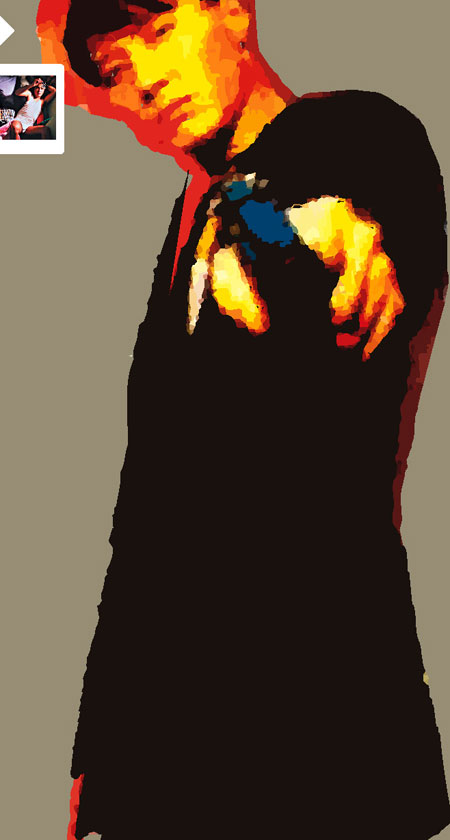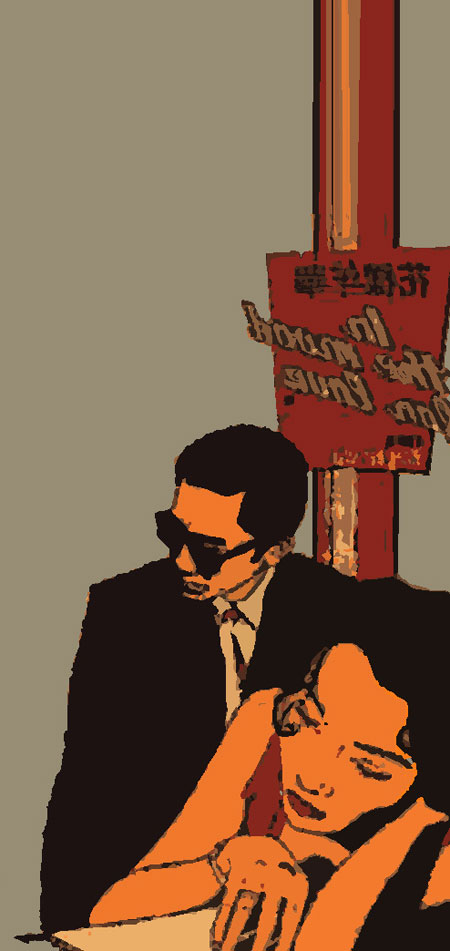wong kar-wai, shooting the instant koldo almandoz
"It is restless moment she has kept her hand lowered, to give him a chance to come closer. But he could not, for lack of courage. She turns and walks away".
Hitz hauekin hasten da Wong Kar-wai zuzendariaren azken filma: “In the mood for love” (Deseando amar). Eta hitzok, primeran azaltzen dute film osoan senti araziko diguna. Desioak eta zalantzak bat egiten duten instant-aren labainkortsuna. Wong Kar-wai Shangain jaio. Sei urte zituenean bere familia Hong- Kong-era joan zen bizitzera. Eta bertako kaosak harrapatu zuen. Raskazieloetako leihoetan arropa zintzilikatzen duten hiriek gaitasun hori dute. Diseinu grafiko ikasketak amaitu eta telebistan hasi zen lanean. Gidoilari. Bere begirada paperetik irudietara eramatea erabaki zuen arte. Jhon Cassavettes, Scorseese eta Truffaut-en bidea jarraitu nahi zuen. Hong-Kong dreaming
“A tears go by” (1988) izan zen bere lehendabiziko filma. Hong Kong-en esklusiboki filmatzen den mafia eta triada generoan sailkatu daiteke. Baina bere opera priman honetan, interes gehiago azaltzen zuen borrokalari eta mafiosoen motibazio esistentzial eta sentimenduetan istorioaren akzioan baino. Eta ekoizleen ustearen aurka, ikusle hongkondarrak liluraturik ateratzen ziren aretoetatik. Bere hurrengo lanak, “Days of beeing wild” (1990), ildo bereari heutsiko dio. 1993 izan zen Wong Kar-waik Hong Kong-eko zinemagintza astindu zueneko urtea. Orduan estreinatu bait zuen “Chungking Express” ziraragarria. Hong Kong izeneko giza erletegian gertatzen diren bi istorio eta lau pertsonaien gorabeherak kontatzen ditu filmak. Eta istorio hauetan, bortizkeri bakarra, egunerokotasunean galtzen diren pertsonaien barne mundua izango da. Eta Beach Boys-en “California dreaming” kantua. Bi istoriotan behin eta berriro errepikatzen den pieza. Kiewloskiren trilogiako pertsonaien moduan, hauek ere, lotura nimiñoak dituzte euren artean, baina elkartu eta euren bizitzak aldatu zezakeen instant hori ez da sekula iristen.
Bere ondorengo filmeek ez zuten Chunking Express-en arrakasta izan. “Ashes of time” (1994), “Fallen Angels” ( 1995) eta “Happy Together” (1997) filmeetan hala ere, bere gai faboritoak islatzen jarraitu zuen: Denboraren iragana, memoria eta identitatea. “In the mood for love” (2000) izan da Wong Kar wai-ren obsesio guztiak bildu dituen lana. Film honetan, instant bakoitza, segundu bakoitza, indar eta intentsitate bereziz ikutua dago. Zuzendari hongkongdarrak, haserako filmeetan erabili zituen kamara geldoa eta muntaia tempoa garatu zituen 60ko hamarkadako Hong Kong-en gertatutako maitasun istorio hau kontatzeko. Bere azken lanari erritmoa dario. Bolero erritmoa. Eta pertsonaiek euren zalantza eta desio munduan harrapatzen gaituzte.
Denboraren ehundurak
Bere filmeetako plano bakoitzean, irudiaren sakontasuna, koloreen erabilera eta elementuen konposizioak garrantzi handia izaten du. Elementu ezberdin horien konbinazioak testura berezia ematen diote bere lanei. Batzuetan, besteetan baino zikinagoa, edo argiagoa, edo higatuagoa... Zuzendari hongkongdarrak ihes egiten dio gainera aurkezpen, korapilo eta amaiera estruktura neoaristotelikoari. Bere istorietako pertsonaiak galduta egoten dira, ez dakiten zerbaiten esperoan. Hori nabarmentzeko, japoniarrek Mono no aware deritzoten kontzeptuan oinarritzen du bere istorien estruktuta. "Bizitzak nora garamatzan ez dakigu, baina beti osatzen du zirkulu bat". Horregatik, Wong Kar-wai-ren filmeetan, bizitza betirako aldatuko digun instant horretatik uste baino gertuago gaudelaren sentsazioa izaten dugu. Instant hori sekula iritsiko ote den ez dakigun arren...
Begirada baten doinuak...
Ezin da Wong Kar-wairen begiradaz hitzegin, belarrietatik sartzen zaigunari erreparatu gabe. Michael Galasso musikariarekin elkarlanean sortzen ditu soinu bandak. Filmeentzat berez konposaturiko piezak –score-ak–, errepikapenean ardazten dira eta errepikapen bakoitzean esananhi berri bat itsasten diote istorioari. Hong Kong-eko paisaiak, “California dreaming” edo Nat King Cole-en “Aquellos ojos verdes” edo “Quizas, quizas, quizas” boleroekin margotzen ditu. Musikaren erabilera eklektiko honek, atmosfera berezi bat sortzeaz gain, zine berezi baten aurrean gaudela erakusten digu. Klitxe edo topikoetatik urruntzen dena. Hong Kong-ik, munduarentzat eginiko istorio Hong-kongdarrak kontatzen dizkiguna. Berezia eta pertsonala. Bere hurrengo filma girotzeko ez dakigu zein musika entzuten ari den. Baina begiak irekita izateaz gain belarriak garbi-garbi izango ditugu.
Hitz hauekin hasten da Wong Kar-wai zuzendariaren azken filma: “In the mood for love” (Deseando amar). Eta hitzok, primeran azaltzen dute film osoan senti araziko diguna. Desioak eta zalantzak bat egiten duten instant-aren labainkortsuna. Wong Kar-wai Shangain jaio. Sei urte zituenean bere familia Hong- Kong-era joan zen bizitzera. Eta bertako kaosak harrapatu zuen. Raskazieloetako leihoetan arropa zintzilikatzen duten hiriek gaitasun hori dute. Diseinu grafiko ikasketak amaitu eta telebistan hasi zen lanean. Gidoilari. Bere begirada paperetik irudietara eramatea erabaki zuen arte. Jhon Cassavettes, Scorseese eta Truffaut-en bidea jarraitu nahi zuen. Hong-Kong dreaming
“A tears go by” (1988) izan zen bere lehendabiziko filma. Hong Kong-en esklusiboki filmatzen den mafia eta triada generoan sailkatu daiteke. Baina bere opera priman honetan, interes gehiago azaltzen zuen borrokalari eta mafiosoen motibazio esistentzial eta sentimenduetan istorioaren akzioan baino. Eta ekoizleen ustearen aurka, ikusle hongkondarrak liluraturik ateratzen ziren aretoetatik. Bere hurrengo lanak, “Days of beeing wild” (1990), ildo bereari heutsiko dio. 1993 izan zen Wong Kar-waik Hong Kong-eko zinemagintza astindu zueneko urtea. Orduan estreinatu bait zuen “Chungking Express” ziraragarria. Hong Kong izeneko giza erletegian gertatzen diren bi istorio eta lau pertsonaien gorabeherak kontatzen ditu filmak. Eta istorio hauetan, bortizkeri bakarra, egunerokotasunean galtzen diren pertsonaien barne mundua izango da. Eta Beach Boys-en “California dreaming” kantua. Bi istoriotan behin eta berriro errepikatzen den pieza. Kiewloskiren trilogiako pertsonaien moduan, hauek ere, lotura nimiñoak dituzte euren artean, baina elkartu eta euren bizitzak aldatu zezakeen instant hori ez da sekula iristen.
Bere ondorengo filmeek ez zuten Chunking Express-en arrakasta izan. “Ashes of time” (1994), “Fallen Angels” ( 1995) eta “Happy Together” (1997) filmeetan hala ere, bere gai faboritoak islatzen jarraitu zuen: Denboraren iragana, memoria eta identitatea. “In the mood for love” (2000) izan da Wong Kar wai-ren obsesio guztiak bildu dituen lana. Film honetan, instant bakoitza, segundu bakoitza, indar eta intentsitate bereziz ikutua dago. Zuzendari hongkongdarrak, haserako filmeetan erabili zituen kamara geldoa eta muntaia tempoa garatu zituen 60ko hamarkadako Hong Kong-en gertatutako maitasun istorio hau kontatzeko. Bere azken lanari erritmoa dario. Bolero erritmoa. Eta pertsonaiek euren zalantza eta desio munduan harrapatzen gaituzte.
Denboraren ehundurak
Bere filmeetako plano bakoitzean, irudiaren sakontasuna, koloreen erabilera eta elementuen konposizioak garrantzi handia izaten du. Elementu ezberdin horien konbinazioak testura berezia ematen diote bere lanei. Batzuetan, besteetan baino zikinagoa, edo argiagoa, edo higatuagoa... Zuzendari hongkongdarrak ihes egiten dio gainera aurkezpen, korapilo eta amaiera estruktura neoaristotelikoari. Bere istorietako pertsonaiak galduta egoten dira, ez dakiten zerbaiten esperoan. Hori nabarmentzeko, japoniarrek Mono no aware deritzoten kontzeptuan oinarritzen du bere istorien estruktuta. "Bizitzak nora garamatzan ez dakigu, baina beti osatzen du zirkulu bat". Horregatik, Wong Kar-wai-ren filmeetan, bizitza betirako aldatuko digun instant horretatik uste baino gertuago gaudelaren sentsazioa izaten dugu. Instant hori sekula iritsiko ote den ez dakigun arren...
Begirada baten doinuak...
Ezin da Wong Kar-wairen begiradaz hitzegin, belarrietatik sartzen zaigunari erreparatu gabe. Michael Galasso musikariarekin elkarlanean sortzen ditu soinu bandak. Filmeentzat berez konposaturiko piezak –score-ak–, errepikapenean ardazten dira eta errepikapen bakoitzean esananhi berri bat itsasten diote istorioari. Hong Kong-eko paisaiak, “California dreaming” edo Nat King Cole-en “Aquellos ojos verdes” edo “Quizas, quizas, quizas” boleroekin margotzen ditu. Musikaren erabilera eklektiko honek, atmosfera berezi bat sortzeaz gain, zine berezi baten aurrean gaudela erakusten digu. Klitxe edo topikoetatik urruntzen dena. Hong Kong-ik, munduarentzat eginiko istorio Hong-kongdarrak kontatzen dizkiguna. Berezia eta pertsonala. Bere hurrengo filma girotzeko ez dakigu zein musika entzuten ari den. Baina begiak irekita izateaz gain belarriak garbi-garbi izango ditugu.




